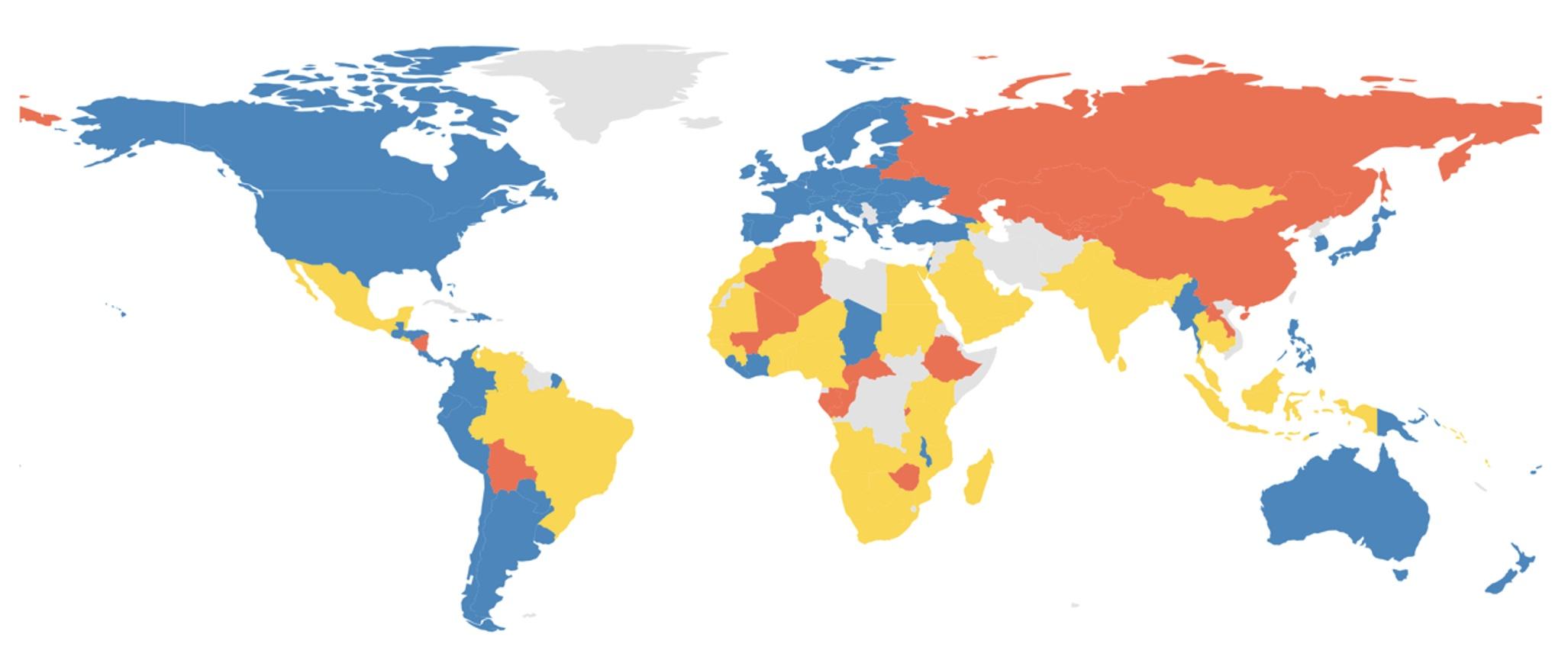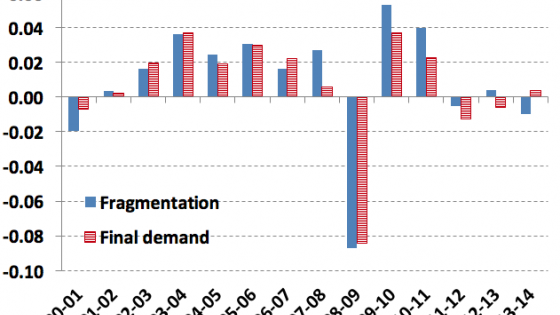Since the end of WWII, the global economy has become increasingly integrated. This process, sustained by transportation, technological advances, and liberalising trade policy, has resulted in an increase of productivity and living standards, boosting economic growth, and contributing to reduce poverty. But trade integration has stalled since the Global Crisis (Cabrillac et al. 2016, Campos et al. forthcoming), uncertainty regarding trade policy has been increasing (Ahir et al. 2022) and trade policy restrictions – in the form of both tariff and non-tariff measures – have regained momentum. Recent examples are the trade tensions between US, China, and other major economies (Fajgelbaum and Khandelwal 2022, Cerdeiro et al. 2021), trade restrictions associated with the Covid-19 crisis (IMF 2022), and economic sanctions imposed in response to the Russian invasion of Ukraine (Gourinchas 2022, Aiyar et al. 2023).
What are the economic consequences of trade fragmentation? In Campos et al. (2023), we provide a new analysis answering this question. The analysis proceeds in two steps. First, we use a new aggregate measure of trade restrictions (MATR of Estefania-Flores et al. 2022) that spans the last 70 years and includes up to 157 countries to estimate the impact on trade of very broad trade policy restrictions in a theory-consistent structural gravity framework.
Second, we use these estimates in a general equilibrium framework to simulate the effect of geopolitical fragmentation on trade.
Fragmentation of world trade
We categorise individual countries as belonging to three blocs according to how they voted in the United Nations (UN) General Assembly on the resolution adopted on 7 April 2022 concerning the suspension of the rights of membership of the Russian Federation in the Human Rights Council. We codify the members who voted against Russia as part of the Western bloc, those who voted with Russia as part of the Eastern bloc, and those who abstained or did not participate as part of the Neutral bloc (Figure 1).
Figure 1 Definition of trade blocs
Note: The figure shows three trade blocs according to how countries voted in the United Nations (UN) General Assembly on the resolution adopted on 7 April 2022 concerning the suspension of the rights of membership of the Russian Federation in the Human Rights Council. Countries shown in blue voted ‘Yes’ and belong to the ‘Western’ bloc. Countries in red voted ‘No’ and belong to the ‘Eastern’ bloc. Countries in yellow either abstained or did not vote and belong to the ‘Neutral’ bloc. Countries shown in grey are countries without a measure of aggregate trade restrictions (MATR) or trade data, and they are excluded from the simulations regardless of their vote.
We construct the fragmentation scenarios by raising bilateral trading costs for trade between countries belonging to opposing blocs. To do so, we search for the highest MATR for each country in the Western and Eastern blocs throughout history and then raise trade costs between any given country and members of the opposing bloc bilaterally to this maximum level. In addition, in our ‘severe fragmentation’ scenario, we simulate a unilateral exit of the Eastern bloc from the WTO – this compromises the ability to trade between the Eastern and the Neutral bloc – and we also assume that all trade agreements between the Eastern and Western bloc are cancelled.
In this scenario, the withdrawal of the Eastern bloc from WTO implies that trade between the Neutral and Eastern bloc falls sharply (dropping by 24%-25%), and trade between the Western and Eastern bloc even more (dropping by 43%-57%). The Neutral bloc and the Western bloc trade more with each other and trade by partners inside each bloc increases. The welfare loss for the median Eastern bloc country is equivalent to a drop of 3.4% in per-capita consumption. For the typical Western bloc country, welfare losses are less: they are equivalent to a loss of 0.8% of per-capita consumption. The typical neutral country experiences a welfare loss that is only slightly below that of the typical Western country: 0.5% of per-capita consumption.
Cross-country heterogeneity
Countries that were more open to begin with are more affected by a fragmentation between blocs, as are countries with strong trade relationships with countries belonging to the opposite bloc. South Korea, Chile, and Peru are examples of this phenomenon, as their strong trade relationship with China is hampered by the fact that China belongs to the Eastern bloc while they are part of the Western bloc. As a result, the effect on their trade flows and welfare is among the largest in the Western bloc. In the Eastern bloc, Hong Kong is in an analogous situation.
Geography also plays an important role, as countries that are in a region that aligns primarily with the opposing bloc experience a sharp increase in the average distance of their trade. Nicaragua and Bolivia are two examples. They belong to the Eastern bloc whereas virtually their neighbours on the American continent align with the Western bloc. Consequently, Nicaragua and Bolivia are placed, respectively, in the first and fourth position in the ranking of countries with the largest welfare drop in the Eastern bloc.
In the Neutral bloc, there are several countries that are hit hard in the more severe fragmentation scenario. The country most affected is Mongolia, which is landlocked between Russia and China. It is expected to suffer a welfare loss equivalent to 6.9% of annual per-capita consumption. Other countries that are affected in a special way in this scenario are Cambodia, Malaysia, Thailand, and Singapore, who are very reliant on trade with China, as well as a number of African and Middle Eastern countries who have strong trade links with China.
Figure 2 Welfare losses in a severe fragmentation scenario
Note: The figure shows the change in welfare in the scenario in which the world fragments into trade blocs and the Eastern bloc exits the WTO. Countries shown in blue experience an improvement in welfare, and those in red a worsening. Units are percentage points. Welfare can be interpreted as the change in the real wage of workers in a country. The scales are different for positive and negative values, and the negative scale is capped at -15.
Real-world costs are likely to be larger
Our static model does not shed light on the transition dynamics, or the economic costs that could accrue when moving from one equilibrium to the other. A point made by Costinot and Rodríguez-Clare (2018) is that various frictions in the reallocation of factors would lead to a slow adjustment to changes in trade costs, implying a lower trade elasticity in the short run and a higher trade elasticity in the long run. Losses from reallocation would then decline over time, so that the present value of losses would exceed losses calculated from the steady state.
In addition, the model does not take into account so-called ‘dynamic gains from trade’ accruing from capital accumulation or innovation. If trade policy becomes more restrictive, as in our fragmentation scenarios, the underlying forces that lead to more capital accumulation and more innovation would work in reverse, implying larger welfare losses.
Authors’ note: The views expressed in this column should not be ascribed to the institutions with which the authors are affiliated.
References
Ahir, H, N Bloom and D Furceri (2022), “Tracking uncertainty in a rapidly changing global economic outlook”, VoxEU.org, 17 December.
Aiyar, S, J Chen, C Ebeke, R Garcia-Saltos, T Gudmundsson, A Ilyina, A Kangur, T Kunaratskul, S Rodriguez, M Ruta, T Schulze, G Soderberg and J P Trevino (2023), “Geoeconomic Fragmentation and the Future of Multilateralism”, IMF Staff Discussion Note 2023/01.
Cabrillac, B, A Al-Haschimi, O Babecka-Kurcharcukova, A Borin, M Bussiere, R Cezar, A Derviz, D Dimitropoulou, L Ferrara, M Gatcher, G Gaulier, J Hukkinen, M Keeney, D Lodge, M Mancini, C Marsilli, J Martinez-Martin, W Mroczek, J Muck, E Pavlova, J Rariga, J Salasevicius, D Santabarbara, F Skudelny, U Slopek, W Steingress, A Tuckett, N van Horen, D van Limbergen, L Walravens and J Worz (2016), “Understanding the weakness in global trade – What is the new normal?”, ECB Occasional Paper Series n.178, September.
Campos, R G, J Estefania-Flores, D Furceri and J Timini (2023), “Geopolitical fragmentation and trade”, Journal of Comparative Economics, in press.
Campos, R, S Pienknagura and J Timini (forthcoming), “How far has globalization gone? (and what is behind it)”, Banco de España Working Paper, forthcoming.
Cerdeiro, D A, R Mano, J Eugster, D V Muir and S J Peiris (2021), “Sizing Up the Effects of Technological Decoupling”, IMF Working Papers, 21/69.
Costinot, A and A Rodríguez-Clare (2018), "The US Gains from Trade: Valuation Using the Demand for Foreign Factor Services", Journal of Economic Perspectives 32(2): 3-24.
Estefania-Flores, J, D Furceri, S A Hannan, J D Ostry and A K Rose (2022), "A Measurement of Aggregate Trade Restrictions and their Economic Effects", IMF Working Papers 2022/001.
Fajgelbaum, P D and A K Khandelwal (2022), “The Economic Impacts of the US-China Trade War”, Annual Review of Economics 14: 205-228.
Gourinchas, P O (2022), “Shifting Geopolitical Tectonic Plates”, IMF Finance and Development, June.
IMF (2022), Regional Economic Outlook: Asia and Pacific.









